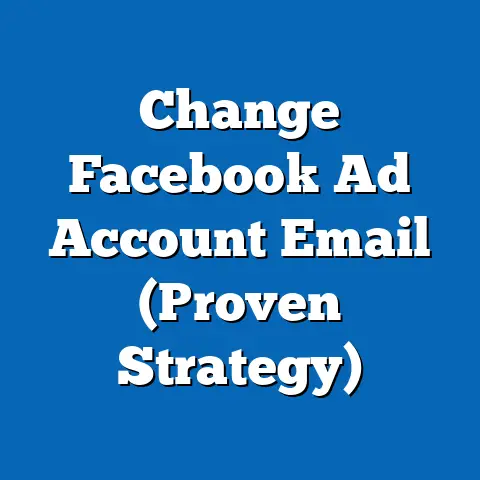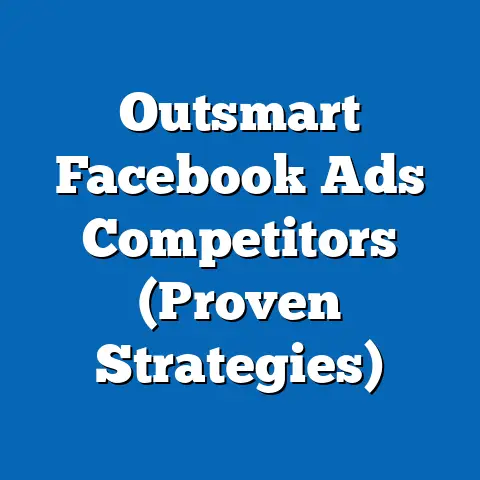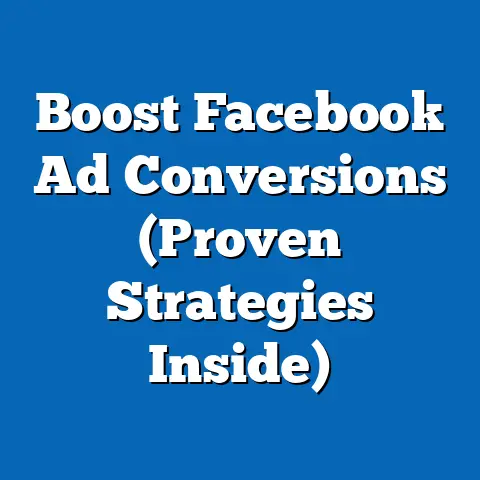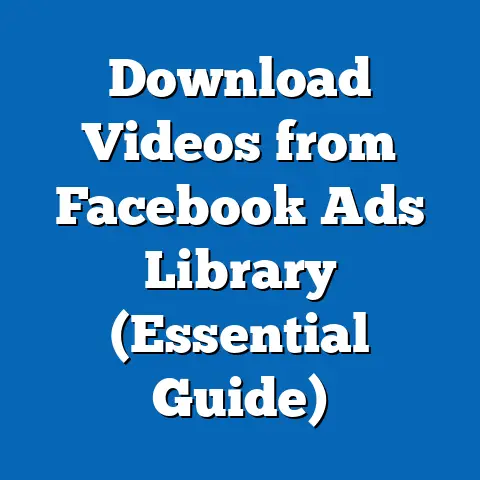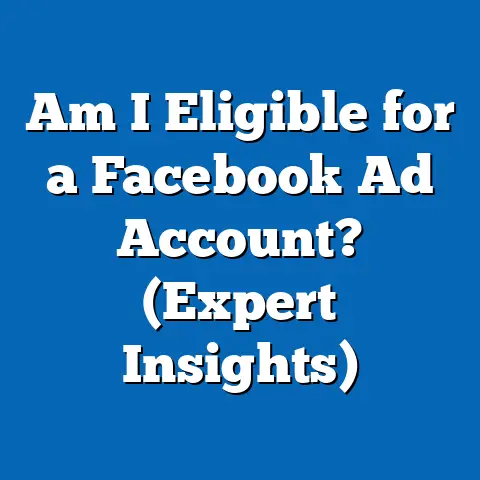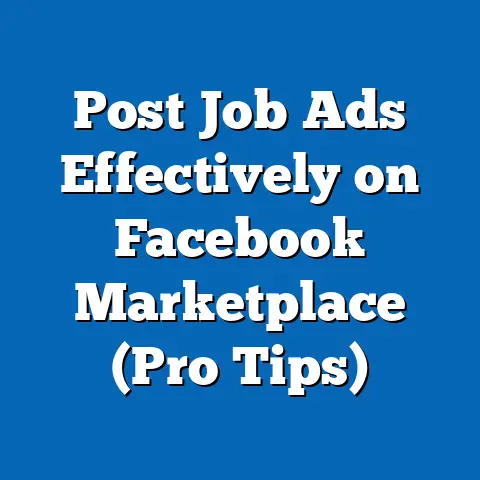Transforming Britain’s Future with Facebook Ads (Strategic Insights)
The digital landscape in Britain has undergone a seismic shift in recent years. No longer are traditional advertising methods the sole domain of businesses vying for consumer attention. Social media platforms, particularly Facebook, have emerged as a cornerstone for organizations of all sizes. With its unparalleled reach and sophisticated targeting capabilities, Facebook Ads are more than just a marketing tool; they’re a transformative force capable of shaping the future of British businesses, communities, and the economy.
I’ve personally witnessed this transformation firsthand. From helping local bakeries attract new customers with visually appealing carousel ads to assisting national charities raise awareness for critical causes through compelling video campaigns, the power of Facebook Ads to connect businesses with their target audiences is undeniable.
Facebook Ads offers a suite of functionalities that make it a compelling platform for advertisers. Think of its precise targeting capabilities – allowing you to pinpoint your ideal customer based on demographics, interests, and behaviors. Consider the diverse ad formats, from engaging carousel ads showcasing multiple products to immersive video ads that tell a brand’s story. And let’s not forget the power of audience insights, providing invaluable data for refining your campaigns and maximizing your return on investment. Retargeting options allow you to re-engage with potential customers who have already shown interest in your products or services, while the analytics dashboard provides real-time data to track performance and optimize your strategy.
The Power of Facebook Advertising in the UK
Facebook’s dominance in the UK social media landscape is undeniable. With millions of active users spanning diverse demographics, it offers an unparalleled opportunity for businesses to reach their target audiences. According to Statista, as of early 2024, Facebook boasts over 44 million users in the UK, representing a significant portion of the population. This widespread adoption makes it a prime platform for businesses looking to connect with potential customers, build brand awareness, and drive sales.
The sheer breadth of Facebook’s user base allows businesses to target specific demographics with remarkable precision. Whether you’re trying to reach young adults interested in fashion, parents seeking educational resources for their children, or retirees looking for travel inspiration, Facebook’s targeting options make it possible to connect with the right people at the right time.
But the power of Facebook Advertising extends far beyond simple demographics. It’s about understanding how different sectors are leveraging the platform to achieve their specific goals. Let’s take a look at some examples:
- Retail: Retail businesses are using Facebook Ads to showcase their products, promote special offers, and drive traffic to their online stores. Carousel ads are particularly effective for displaying multiple products in a visually appealing format, while dynamic product ads allow businesses to retarget users with products they’ve previously viewed on their website.
- Education: Educational institutions are using Facebook Ads to attract prospective students, promote courses and programs, and build brand awareness. Targeted ads can be used to reach students based on their academic interests, geographic location, and educational goals.
- Nonprofit: Nonprofit organizations are using Facebook Ads to raise awareness for their cause, solicit donations, and recruit volunteers. Compelling video ads can be used to tell powerful stories and connect with potential donors on an emotional level.
- Hospitality: Hotels, restaurants, and other hospitality businesses are using Facebook Ads to attract tourists, promote seasonal specials, and drive bookings. Location-based targeting allows businesses to reach travelers in specific geographic areas, while visually appealing ads can showcase the unique features of their properties.
I’ve seen countless British companies effectively leverage Facebook Ads to achieve significant growth and impact. One example that stands out is a local artisan cheese producer in Cornwall. They struggled to reach a wider audience beyond their immediate geographic area. By implementing a targeted Facebook Ads campaign focusing on food enthusiasts across the UK, they were able to increase online sales by 30% within just a few months. Their success was driven by compelling product photography, engaging ad copy that highlighted the unique qualities of their cheese, and precise targeting that reached the right audience.
Another inspiring example involves a social enterprise in Manchester that provides training and employment opportunities for disadvantaged youth. They used Facebook Ads to raise awareness for their programs and solicit donations from the local community. By sharing powerful stories of the young people they’ve helped, they were able to connect with potential donors on an emotional level and significantly increase their fundraising efforts.
These are just a few examples of the transformative power of Facebook Advertising in the UK. By understanding the platform’s capabilities and leveraging its strategic advantages, businesses and organizations of all sizes can achieve their goals and make a positive impact on their communities.
Takeaway: Facebook’s widespread adoption and sophisticated targeting options make it a powerful platform for businesses in the UK. By understanding how different sectors are leveraging the platform and learning from successful case studies, you can unlock its potential for your own organization.
Key Functionalities of Facebook Ads
Facebook Ads isn’t just about placing an ad and hoping for the best. It’s about leveraging a suite of powerful functionalities that allow you to target your audience with precision, create engaging ad experiences, and optimize your campaigns for maximum ROI. Let’s dive deep into the core functionalities that make Facebook Ads such a potent marketing tool:
Targeting Options: Precision at Your Fingertips
One of the most compelling features of Facebook Ads is its unparalleled targeting capabilities. It allows you to pinpoint your ideal customer based on a wide range of factors, ensuring that your ads are seen by the people who are most likely to be interested in your products or services.
- Demographic Targeting: This allows you to target users based on their age, gender, education level, relationship status, and other demographic characteristics. For example, if you’re selling baby products, you can target new parents within a specific age range.
- Geographic Targeting: This allows you to target users based on their location, whether it’s a country, region, city, or even a specific postcode. This is particularly useful for businesses with a local focus, such as restaurants or retail stores.
- Interest Targeting: This allows you to target users based on their interests and hobbies, as expressed through their Facebook activity. For example, if you’re selling hiking equipment, you can target users who have expressed an interest in hiking, camping, or outdoor activities.
- Behavioral Targeting: This allows you to target users based on their online behavior, such as their purchase history, browsing activity, and device usage. For example, you can target users who have recently visited your website or made a purchase from a competitor.
- Custom Audiences: This allows you to upload your own customer data, such as email addresses or phone numbers, and target those users with your ads. This is a powerful way to re-engage with existing customers or target potential customers who have already shown interest in your brand.
- Lookalike Audiences: This allows you to create new audiences that are similar to your existing customers or website visitors. Facebook analyzes the characteristics of your source audience and identifies other users who share those same characteristics. This is a great way to expand your reach and find new customers who are likely to be interested in your products or services.
I remember working with a small online retailer selling handmade jewelry. They initially struggled to reach a wider audience beyond their immediate social circle. By leveraging Facebook’s targeting options, we were able to create a custom audience based on their existing customer list and then create a lookalike audience to target new potential customers with similar interests and demographics. This resulted in a significant increase in website traffic and sales.
Ad Formats: Engaging Your Audience
Facebook offers a variety of ad formats to suit different marketing objectives and target audiences. Each format has its own unique strengths and weaknesses, so it’s important to choose the right format for your specific campaign.
- Image Ads: These are simple ads that consist of an image and some text. They’re a great way to showcase your products or services and drive traffic to your website.
- Video Ads: These are ads that consist of a video and some text. They’re a great way to tell your brand’s story, engage your audience, and drive conversions.
- Carousel Ads: These are ads that consist of multiple images or videos that users can swipe through. They’re a great way to showcase multiple products or services in a single ad.
- Collection Ads: These are ads that allow users to browse and purchase products directly from the ad. They’re a great way to drive sales and increase revenue.
- Lead Ads: These are ads that allow users to submit their contact information directly from the ad. They’re a great way to generate leads and build your email list.
- Instant Experience Ads: These are full-screen ads that provide an immersive experience for users. They’re a great way to tell your brand’s story and engage your audience.
I’ve found that video ads are particularly effective for capturing attention and driving engagement. A well-produced video can tell a compelling story, showcase your brand’s personality, and connect with your audience on an emotional level. However, it’s important to ensure that your video is optimized for mobile viewing, as most Facebook users access the platform on their smartphones.
Budgeting and Bidding: Maximizing Your ROI
Facebook Ads allows you to set a budget for your campaigns and choose a bidding strategy that aligns with your marketing objectives. This gives you control over your ad spend and allows you to optimize your campaigns for maximum ROI.
- Daily Budget: This is the average amount you’re willing to spend on your ads each day.
- Lifetime Budget: This is the total amount you’re willing to spend on your ads over the entire duration of the campaign.
- Automatic Bidding: This allows Facebook to automatically set your bids based on your budget and targeting options. This is a good option for beginners or for campaigns where you’re not sure what to bid.
- Manual Bidding: This allows you to manually set your bids for each ad set. This gives you more control over your ad spend and allows you to optimize your campaigns for maximum ROI.
- Cost Per Click (CPC) Bidding: This means you pay each time someone clicks on your ad.
- Cost Per Impression (CPM) Bidding: This means you pay for every 1,000 times your ad is shown.
- Cost Per Acquisition (CPA) Bidding: This means you pay each time someone takes a desired action, such as making a purchase or filling out a form.
I’ve found that it’s important to experiment with different bidding strategies to see what works best for your specific campaign. For example, if you’re trying to drive traffic to your website, CPC bidding may be the best option. However, if you’re trying to build brand awareness, CPM bidding may be more effective.
Analytics and Reporting: Measuring Your Success
Facebook Ads provides a robust analytics dashboard that allows you to measure the performance of your campaigns and adjust your strategies in real-time. This data-driven approach is essential for optimizing your ad spend and maximizing your ROI.
- Impressions: The number of times your ad was shown.
- Reach: The number of unique people who saw your ad.
- Clicks: The number of times people clicked on your ad.
- Click-Through Rate (CTR): The percentage of people who saw your ad and clicked on it.
- Conversions: The number of people who took a desired action, such as making a purchase or filling out a form.
- Cost Per Conversion (CPC): The amount you paid for each conversion.
- Return on Ad Spend (ROAS): The amount of revenue you generated for every dollar you spent on ads.
I always emphasize the importance of tracking your key metrics and analyzing your data on a regular basis. This will help you identify what’s working and what’s not, and make adjustments to your campaigns accordingly. For example, if you’re seeing a low CTR, you may need to revise your ad copy or targeting options. If you’re seeing a high CPC, you may need to adjust your bidding strategy.
Takeaway: Facebook Ads offers a powerful suite of functionalities that allow you to target your audience with precision, create engaging ad experiences, and optimize your campaigns for maximum ROI. By understanding and leveraging these functionalities, you can unlock the true potential of Facebook Advertising for your business.
Strategic Insights for Effective Facebook Advertising
Creating successful Facebook Ads campaigns requires more than just understanding the platform’s functionalities. It requires a strategic approach that considers your target audience, marketing objectives, and overall business goals. Here are some key strategies for creating effective Facebook Ads campaigns:
Crafting Compelling Ad Copy: Speak to Your Audience
Your ad copy is your opportunity to grab your audience’s attention and persuade them to take action. It should be clear, concise, and relevant to your target audience. Here are some best practices for writing engaging and persuasive ad copy:
- Know Your Audience: Understand their needs, interests, and pain points. Use language that resonates with them and addresses their specific concerns.
- Highlight the Benefits: Focus on the benefits of your product or service, rather than just the features. Explain how it will solve their problems or improve their lives.
- Use Strong Calls to Action: Tell your audience what you want them to do, whether it’s visiting your website, making a purchase, or filling out a form. Use clear and concise calls to action, such as “Shop Now,” “Learn More,” or “Get a Free Quote.”
- Keep it Concise: People have short attention spans, so keep your ad copy brief and to the point. Use short sentences and paragraphs, and avoid jargon or technical terms.
- Use Numbers and Statistics: Numbers and statistics can add credibility to your ad copy and make it more persuasive. For example, instead of saying “Our product is very effective,” say “Our product is 90% effective.”
I’ve found that using a question in your ad copy can be a great way to grab attention and engage your audience. For example, instead of saying “Our product will solve your problems,” you could say “Are you tired of dealing with [problem]? Our product can help!”
Visual Storytelling: Capture Their Imagination
High-quality visuals are essential for capturing attention and enhancing brand storytelling. Whether you’re using images or videos, your visuals should be visually appealing, relevant to your target audience, and consistent with your brand’s identity.
- Use High-Quality Images and Videos: Avoid blurry or pixelated images and videos. Use professional-quality visuals that showcase your products or services in the best possible light.
- Tell a Story: Use your visuals to tell a story that resonates with your target audience. Show how your product or service can improve their lives or solve their problems.
- Use Eye-Catching Colors and Designs: Use colors and designs that are visually appealing and consistent with your brand’s identity.
- Optimize for Mobile Viewing: Most Facebook users access the platform on their smartphones, so make sure your visuals are optimized for mobile viewing. Use vertical or square formats, and keep your text concise and easy to read.
I always recommend using real-life photos and videos of your products or services in action. This can help build trust and credibility with your audience and make your ads more relatable.
A/B Testing: Refine Your Performance
A/B testing, also known as split testing, is the process of comparing two versions of an ad to see which one performs better. This is an essential practice for refining your ad performance and maximizing your ROI.
- Test One Variable at a Time: When A/B testing, it’s important to test only one variable at a time. This will allow you to accurately measure the impact of that variable on your ad performance.
- Test Different Ad Copy: Experiment with different headlines, body text, and calls to action to see which ones resonate best with your target audience.
- Test Different Visuals: Experiment with different images and videos to see which ones capture the most attention and drive the most engagement.
- Test Different Targeting Options: Experiment with different demographic, interest, and behavioral targeting options to see which ones reach the most relevant audience.
- Use a Statistical Significance Calculator: Use a statistical significance calculator to determine whether the results of your A/B test are statistically significant. This will help you avoid making decisions based on random chance.
I’ve found that A/B testing is particularly effective for optimizing your ad copy. Even small changes to your headline or call to action can have a significant impact on your ad performance.
Retargeting Strategies: Re-Engage Your Audience
Retargeting is the process of showing ads to people who have already interacted with your brand, whether it’s visiting your website, viewing your products, or engaging with your social media posts. This is a powerful way to re-engage potential customers who have already shown interest in your brand and increase your chances of making a sale.
- Website Retargeting: Show ads to people who have visited your website. This is a great way to remind them of your products or services and encourage them to make a purchase.
- Product Retargeting: Show ads to people who have viewed specific products on your website. This is a great way to remind them of those products and encourage them to add them to their cart.
- Email Retargeting: Show ads to people who are on your email list. This is a great way to promote special offers, announce new products, and drive traffic to your website.
- Video Retargeting: Show ads to people who have watched your videos on Facebook or YouTube. This is a great way to re-engage with viewers and encourage them to take the next step.
I’ve seen retargeting campaigns generate impressive results for businesses of all sizes. By re-engaging with potential customers who have already shown interest in your brand, you can significantly increase your chances of making a sale.
Takeaway: Creating effective Facebook Ads campaigns requires a strategic approach that considers your target audience, marketing objectives, and overall business goals. By crafting compelling ad copy, using high-quality visuals, A/B testing your ads, and implementing retargeting strategies, you can unlock the true potential of Facebook Advertising for your business.
The Economic Impact of Facebook Ads on Britain
The widespread adoption of Facebook Ads is having a significant impact on the UK economy, contributing to growth, job creation, and increased market competition. It’s democratizing access to advertising, empowering small businesses and startups to compete with larger corporations on a more level playing field.
Facebook commissioned a study by Deloitte in 2020 which found that Facebook supported 227,000 jobs in the UK and contributed £14.6 billion to the UK economy. While these figures are from a few years ago, they illustrate the significant economic impact that Facebook has on the UK.
One of the key ways that Facebook Ads is contributing to economic growth is by enabling businesses to reach new customers and expand their market reach. By targeting specific demographics and interests, businesses can connect with potential customers who would otherwise be difficult to reach through traditional advertising methods. This increased market reach can lead to higher sales, increased revenue, and ultimately, economic growth.
Facebook Ads is also contributing to job creation in digital marketing and adjacent industries. As more businesses embrace Facebook Advertising, the demand for skilled digital marketers, ad specialists, and content creators is growing. This is creating new job opportunities for young people and experienced professionals alike.
The rise of Facebook Advertising is also leveling the playing field for small businesses and startups. In the past, advertising was often prohibitively expensive for smaller companies, making it difficult for them to compete with larger corporations. Facebook Ads has made advertising more accessible and affordable, allowing small businesses to reach a wider audience and compete more effectively.
I’ve seen firsthand how Facebook Ads can transform small businesses. A local coffee shop in my neighborhood was struggling to attract new customers. By implementing a targeted Facebook Ads campaign, they were able to reach a wider audience in the local community and increase their foot traffic significantly. This not only helped them grow their business but also created new job opportunities for local residents.
However, it’s important to acknowledge that the rise of Facebook Advertising also presents some challenges. The increased competition for ad space can drive up costs, making it more difficult for smaller businesses to compete. Additionally, concerns about data privacy and the ethical use of advertising are growing, requiring businesses to be more transparent and responsible in their advertising practices.
Takeaway: Facebook Ads is having a significant economic impact on Britain, contributing to growth, job creation, and increased market competition. While there are some challenges to address, the platform’s democratizing effect on advertising is empowering small businesses and startups to compete more effectively and drive economic growth.
Future Trends in Facebook Advertising
The world of Facebook Advertising is constantly evolving, with new technologies, algorithms, and user behaviors shaping the future of the platform. To stay ahead of the curve, businesses need to be aware of emerging trends and adapt their strategies accordingly. Here are some key trends that could influence the future of Facebook Ads in Britain:
- The Impact of AI and Machine Learning: AI and machine learning are already playing a significant role in Facebook Advertising, powering features such as automated bidding, audience targeting, and ad optimization. In the future, AI and machine learning are likely to become even more sophisticated, enabling businesses to create more personalized and effective ad campaigns.
- The Role of Privacy Regulations: Privacy regulations such as GDPR are having a profound impact on the way businesses collect and use data for advertising purposes. In the future, businesses will need to be even more transparent about their data practices and obtain explicit consent from users before collecting and using their data.
- The Shift Towards Video Content: Video content is becoming increasingly popular on Facebook, with users spending more time watching videos than ever before. In the future, businesses will need to prioritize video content in their advertising strategies to capture audience attention and drive engagement.
- The Rise of Interactive Ads: Interactive ads, such as quizzes, polls, and games, are becoming increasingly popular on Facebook. These ads provide a more engaging and interactive experience for users, leading to higher click-through rates and conversions.
I believe that AI and machine learning will be particularly transformative in the years to come. As these technologies become more sophisticated, they will enable businesses to create more personalized and effective ad campaigns, targeting the right people with the right message at the right time.
However, it’s also important to be mindful of the ethical implications of AI and machine learning. Businesses need to ensure that these technologies are used responsibly and ethically, and that they don’t discriminate against certain groups or violate users’ privacy.
To prepare for these changes, businesses should:
- Invest in AI and Machine Learning: Start experimenting with AI and machine learning tools to see how they can improve your advertising performance.
- Prioritize Data Privacy: Be transparent about your data practices and obtain explicit consent from users before collecting and using their data.
- Embrace Video Content: Create high-quality video content that is engaging, informative, and relevant to your target audience.
- Experiment with Interactive Ads: Try creating interactive ads that provide a more engaging and interactive experience for users.
Takeaway: The future of Facebook Advertising is likely to be shaped by AI, machine learning, privacy regulations, video content, and interactive ads. By staying informed about these trends and adapting your strategies accordingly, you can stay ahead of the curve and maximize your advertising ROI.
Conclusion
Facebook Ads have emerged as a transformative force for British businesses and society at large. Its unparalleled reach, sophisticated targeting capabilities, and diverse ad formats make it a powerful tool for connecting with target audiences, driving sales, and achieving marketing objectives.
From helping local businesses thrive to enabling nonprofits to raise awareness for critical causes, Facebook Ads is democratizing access to advertising and empowering organizations of all sizes to compete on a more level playing field. The economic impact of Facebook Ads on Britain is undeniable, contributing to growth, job creation, and increased market competition.
However, it’s important to acknowledge that the world of Facebook Advertising is constantly evolving. New technologies, algorithms, and user behaviors are shaping the future of the platform, requiring businesses to stay informed and adapt their strategies accordingly.
By understanding and leveraging Facebook’s functionalities, crafting compelling ad copy, using high-quality visuals, A/B testing your ads, and implementing retargeting strategies, you can unlock the true potential of Facebook Advertising for your business. As we look to the future, it’s clear that Facebook Ads will continue to play a central role in the digital advertising landscape in Britain. By embracing innovation, prioritizing data privacy, and adapting to emerging trends, businesses can continue to leverage the power of Facebook Ads to shape a brighter future for themselves and the British economy.
I encourage you to take the insights and strategies shared in this guide and apply them to your own Facebook Ads campaigns. Experiment, analyze, and adapt to find what works best for your business. The transformative potential of Facebook Ads is within your reach.

